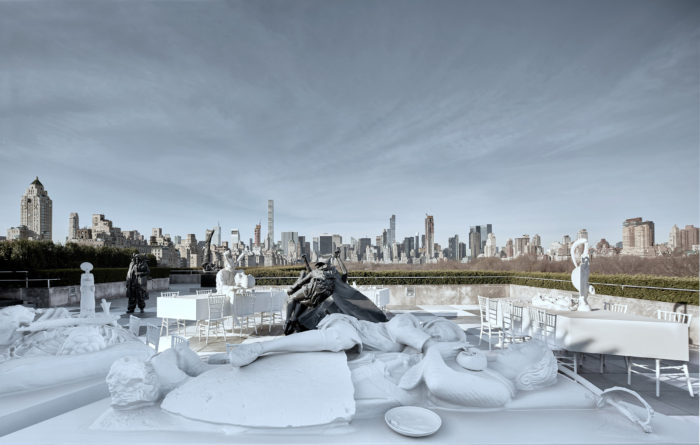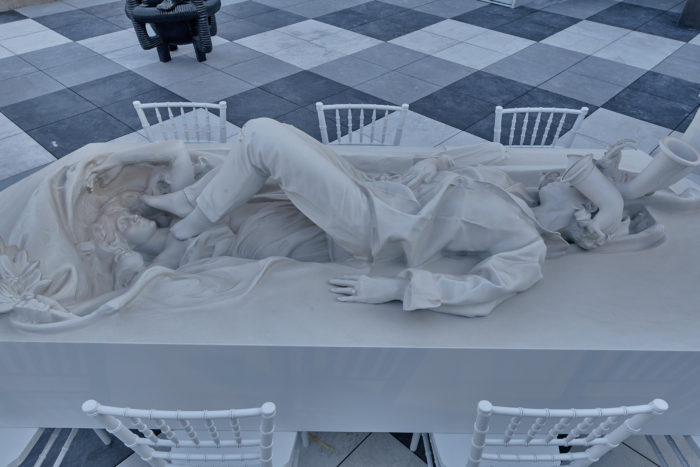
Adrián Villar Rojas, not yet forty and already notorious, stands out as a bit of a bad boy—albeit one supported by the venerable avant-garde gallery run by Marian Goodman, who sells difficult, hard to understand artists for high prices. There is nothing wrong in the gallerist’s doing so—Goodman has been a major supporter of cutting-edge artists, usually European, for decades—but it is a bit strange to see how quickly the art world has lined up behind the often baroque nature of Rojas’s ambition. Commissioned by the Met as a site-specific project, the installation, entitled “The Theater of Disappearance,” consists of sixteen large sculptures spread out across the rooftop garden of the museum, bringing attention not only to the pieces themselves, but also the new bar, the plants surrounding the periphery of the open space, and public furniture. The sculptures are highly eclectic and more than a little strange: the human figures are encrusted with, overall, close to one hundred objects from many cultures and epochs—artifacts from the museum itself. Both the figures and the museum objects were scanned for reproduction; the latter were attached helter-skelter to the figures, without real consideration for elegant placement or historical or cultural continuity. Displayed without regard for effective orientation among the young crowd, which when I visited the site seemed more interested in socializing than pondering the eccentric meaning of the exhibition, “The Theater of Disappearance” felt, sadly, more like an afterthought than the display of a brilliant young sculptor.

But then this has often been the case with the presentations encountered on the Met’s roof: the trees of Central Park and the buildings surrounding the site regularly undermine the interest of the work placed before its audience. Of course the museum wants visitors to engage the art, but perhaps not in a highly intensive manner—by relying on the ready audience of museum visitors, mostly drawn to the roof for socializing and for refreshments and for a view of the city, the projects have always had many sophisticated—but distracted—viewers to look at the work. Clearly, it does not always happen that these visitors take into close account the nature of the art. This particular point may have been intensified by the truly quirky nature of the work by Rojas, whose embellished figures seemed obscure and opaque—the kind of work more justifiable by theory than by experience. Sculpturally, the individual pieces didn’t truly connect with each other, or relate effectively to their surroundings. But, perhaps, the kind of thematic continuities we might expect from this project were not intended by the artist. Actually, his sculptures’ jumbled accumulations of other objects felt most effective as a comment on the sheer numbers and ubiquity of protected artifacts. Because the Met, more than most American museums, functions as a warehouse for world history, today we usually experience its holdings outside their context, rather than neatly fitting into a niche that supports historical integrity. As a result, it becomes a form of entertainment.

Museums have always been seen as stewards of cultural history; but now, they function less like a university communicating knowledge and more like a supermarket, offering items for delectation across geographies and time. This is perhaps a bit simple as a description, but the truth is that the museum has been forced into an odd corner, populist in nature, by its own success. People, we have known for decades now, currently consume art rather than study it. The visitor’s gaze has shifted from history to the museum shop—even when he is looking at real art. In witness of the depreciation of the art object, Rojas’s appropriation of museum works is eclectic in the extreme, including the sixteen human figures, some reclining, some sitting, and some standing; tables with chairs and random placements of crockery; even a very curious work in which a man is sitting on a table, his eyes encircled by the fingers of a woman whose arms move upward but end abruptly, a bit beyond the elbow, in mid-air. The figure sits, regarding with a steady gaze the comic head of a hippo he holds in his hands.

One work with an entirely black exterior combines a black woman in a modern dress, clasped by a large serpent with a diamond pattern on its back. As part of the pedestal supporting this odd amalgam of images, the sculpture of an African head presents itself close to the bottom of the support. The mixed-up manner in which the work is connected and brought to light feels like a contemporary attempt to present a theme that is rendered complex by an entirely random set of visual association. Any attempt at historical sequencing and scholarly specificity has fallen by the wayside, in favor of a cultural buffet of separate effects. This is the way we see art now: as a mélange of unconnected references rather than an orderly procession. But when was art truly an orderly procession?
Perhaps Rojas’s work in choosing the object with the different curators of the museum reflects a kaleidoscopic intelligence. Everything in his art is happening at once. But the presentation of the works of art that surround the human figure tends to destroy any coherent story about them. Additionally, the lack of a highly focused audience undermines the nature of the museum experience. Viewers need a dialogue between their imagination and the object they regard. Because both the figures and their accompanying artifacts were scanned, we experience Rojas’s sculptures as we might a photo—in the sense that we are looking at something, at a remove from reality. But now the actual relation between the copy and the original has become moot; we accept the copy much more freely than we did before. We know, for example, that a German museum is now offering digital prints of drawings in its galleries rather than the actual works of art, in order to protect the latter from damage from light.

Technologies distancing us from the real thing is hardly a new issue; it has been alive since the writings of Walter Benjamin. But Rojas is not only distancing us from the reality of the objects he has scanned, he is also furthering the gap between our experience of the works he has chosen, and our sense of a true historical tradition. In a time when we don’t know much about the culture from which the artifact comes from, theory becomes more important than actual scholarly knowledge. But theory cannot supplant effective scholarly investigation. It can’t because an object is inevitably indicative of its culture, and its physical existence resists the abstractions of theory. So Rojas, in his exaggerated, ahistorical treatment of the artifacts, forgoes narrative for a loose association of thematic similarity.
Indeed, that is often the way objects were treated in museums before our readings of its context became more historically accurate. By borrowing from the museum’s collection the differing works of art that make up his project, Rojas enlarges the possibilities of his cultural imagination. This would be a highly effective way of challenging traditional notions of creativity. Perhaps that is Rojas’s point—that the gathering of historical art objects results in an imagination that always looks backward, even when the work is intended to be original and new. Looked at closely, especially from a scholarly point of view. Rojas is creating a mystique based on objects whose associations we simply don’t know.

Inevitably we lose as much as we gain from the de-contextualization of art artifacts. Isolating the art so that its associations are purely contemporary means that we lose a great deal—the roof becomes a place where visitors drink their wine, and the artworks and their references, no longer clear, go very much unnoticed. Perhaps this shoe reveals the need for a new historicism—not in the sense of dogged, uninspired appraisal, but rather as an informed conjecture. Rojas invites criticism by clinging to a strategy that duplicates museum materials without integrating them within an informative milieu. We only learn by comparison. Rojas’s decision to merge artistic periods and cultures makes sense in a world where we can change points of view with a click of the mouse, but it does not work if we view history as an intentionally arranged slide show. And we must remember that the idea of progress is antithetical to art history. Our cultural story has very little to do with progress—as an artist friend told me, there is no greater or lesser meaningfulness, only difference; this insight can be applied to naive notions of cultural progress. Still, when we attempt to do away with difference, as Rojas does in his democratically driven appropriation of disparate artworks, we also lose the particularities that make art interesting. My students in art school do not want a monoculture in any way. Difference is all we have left in the face of an increasing preference, driven by industry and cash, for the same culture all over the world. Increasingly, in our ignorance, we demand that we live within a uniformity that amounts to a rejection of life’s differences.
The Roof Garden Commission: Adrián Villar Rojas, The Theater of Disappearance
The Metropolitan Museum of Art
April 14 – October 29, 2017
– Jonathan Goodman
Photos provided by The Metropolitan Museum

En Septiembre, yo fui al “Met” para vi dos exposiciones. Uno fue de Adrián Villar Rojas que se llama “El Teatro de la Desaparición”. El otro fue de Cristóbal de Villalpando, un pintor Mexicano de la época Barroco. Yo no sabía nada sobre los dos artistas cuando llegué al museo. La exhibición de Villalpando fue maravilloso. Es estupendo que Villalpando pintara un cuadro tan grande! Sin embargo, hay muchas referencias al Cristianismo en su arte que yo no entendía. Por eso, me gusta la exhibición de Adrián Villar Rojas más.
Es increíble que la exhibición de Rojas sea en el techo del Met. Fue un día muy bueno cuando fui y podía ver el horizonte de la ciudad de Nueva York. A mí me gusta que Rojas incluyera el arte de otros partes del Met. Supongo que Rojas quería hacer un homenaje al museo porque él gastó mucho tiempo en el museo- seleccionando los pedazos, escaneando los, y poniendo su arte en el techo. Me parece bien que Rojas quisiera remodelar el arte del pasado porque tantos artistas solo quieren crear arte nuevo.
Es interesante que Rojas usara el color blanco en muchos de sus esculturas porque los Griegos usaban blanco en sus esculturas. Al mismo tiempo, el arte de Rojas evoca pensamientos del futuro porque usaba la tecnología de imprimiendo en 3D, y del mundo antiguo.